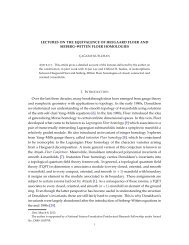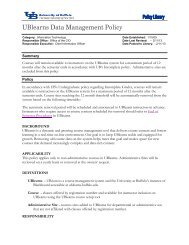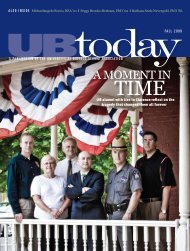A WALK IN THE WOODS - University at Buffalo
A WALK IN THE WOODS - University at Buffalo
A WALK IN THE WOODS - University at Buffalo
You also want an ePaper? Increase the reach of your titles
YUMPU automatically turns print PDFs into web optimized ePapers that Google loves.
“It’s a business,” M<strong>at</strong>hes chimes in.Th<strong>at</strong>’s not to say the three haven’t wonparts. At the same time, they have learnedhow stereotyped women’s roles can be.McDowall, for example: With her curlybrown hair, curvy figure and husky voice,she’s usually cast as “funny, or bitchy or thesidekick.” “Some roles have been good,”she says—she especially enjoyed a short,independent comedy film she appeared inthis year, “Future Assassin.” “And some Ijust chalk up to experience,” she adds.Although M<strong>at</strong>hes has struggled todistinguish herself from (in her words) “allthe other girls with brown hair and blueeyes,” she has started to find her niche.She enjoyed her work with “School Spirits”for the Syfy network, for example, whichreenacts reports of on-campus paranormalevents. “It was an amazing experience ofwh<strong>at</strong> being on set is like,” she says. Shespent about six hours in a swimming poolfor one episode, doing laps to the pointof exhaustion. Is she a swimmer? “Notreally,” she says. “Th<strong>at</strong>’s why I’m an actor.To experience life from different points ofview, to live another life for a few minutes.”Raymond is represented by two agencies,which is a huge step for an actor. She’sin the adult and youth departments—andbecause of her small frame and highpitchedvocal range, she is almost alwayscast in teenage roles. “I’ve been cast as acharacter named Minnie,” she laments,and she recently voiced Sally Brown fora “Peanuts” anim<strong>at</strong>ion. But she has alsoplayed Tricia in the play “Dog Sees God,”which reimagines the Peanuts characters(Tricia = Peppermint P<strong>at</strong>ty) as troubledteenagers, <strong>at</strong> an off-Broadway the<strong>at</strong>er.One reviewer called her “the perfect ‘MeanGirl.’”At the same time, the reality is they alsohave to have “survival jobs,” as Raymondcalls them: McDowall is a wardrobe supervisor—sheregularly works for Juilliard andpicks up work for organiz<strong>at</strong>ions like theJoffrey Ballet. She is also a teaching artist<strong>at</strong> the Harlem School of the Arts, an afterschoolprogram. M<strong>at</strong>hes works full time<strong>at</strong> a bar, and Raymond is a maître d’ for arestaurant and sells skin-care products.“You need to be able to sit in the middleof this teeter-totter,” says M<strong>at</strong>hes, holdingout her hands like the scales of justice.“And keep them in balance. You are yourown enterprise, and you have to tre<strong>at</strong> it assuch in order to survive—for your own sanity,and to get in front of the right people.”“You never have a day where you’re notdoing something,” says Raymond. “You’realways running, running, running.”Then, they decided to start setting theirown pace.Act Three:Radium GirlsOne day l<strong>at</strong>e last year, Raymond andM<strong>at</strong>hes took a scene study class together.It’s the kind of thing motiv<strong>at</strong>ed actors doto keep themselves sharp. While rehearsing,they got to talking—and dreaming.“We said, you know, let’s do somethingwe can be in control of,” recalls Raymond.McDowall joined in the convers<strong>at</strong>ion aboutroles they’d like to take on, books they hadread and plays th<strong>at</strong> had inspired them, inparticular, plays in which female characterswere not just talking about shoppingor men.Within a month, they had held a launchparty for their new company, The RadiumGirls (TRG), named in honor of aninspiring group of women from the early20th century (see sidebar). “The gre<strong>at</strong>thing about TRG is th<strong>at</strong> each girl bringssomething interesting and necessary to thespectrum,” says Kashana Young, one of thecompany’s major backers. “There is nothingthese girls can’t do. If there is, thankfullyfor us, they know their limit<strong>at</strong>ions.TRG are grounded and realistic and do notwaste time with fanciful dreams.”There was no time for “fanciful dreams”between TRG’s launch party in December2012 and the May 22, 2013, opening oftheir first show, Alan Ball’s comedy “FiveWomen Wearing the Same Dress,” <strong>at</strong> Manh<strong>at</strong>tan’sBridge The<strong>at</strong>re. The three pulledtogether and did everything from securinga the<strong>at</strong>er to learning their parts to castingthe other roles to selling tickets.“Our professors always told us aboutthis,” says Raymond. “‘You’re going to bedoing the<strong>at</strong>er in the smallest spaces. You’regoing to be sweeping the floors yourself,doing your own hair.’ For this show, I washanging wallpaper, sweeping floors, actingand producing. I was like, ‘Wow, this isexactly wh<strong>at</strong> they were talking about!’”They swept up quite a few talented collabor<strong>at</strong>orsalong the way and inspired themto don<strong>at</strong>e their time and talents—peoplelike Jaime Torres, a friend of McDowallfrom her wardrobing work, who did thecostume design. It’s a key position in a playth<strong>at</strong> revolves around five bridesmaids for aSouthern summer wedding. “[The dressesare] supposed to be tacky without actuallylooking terrible,” Torres explains. Heloc<strong>at</strong>ed peach-colored readymade dressesand added lace and beads to fit the part,and cre<strong>at</strong>ed h<strong>at</strong>s for them as well. “I loggeda lot of hours,” he says with a laugh. “It wasa lot of hand-sewing. But I had a very personalconnection to the show and wantedto give them the best they could get.”The work paid off. Two among the <strong>at</strong>tendeesof their sold-out audiences wereHenry and Jo Strouss, who got to knowM<strong>at</strong>hes from her “survival job” as a bartenderand have become her p<strong>at</strong>rons. “Itis easy in New York just to go to performanceson Broadway,” says Henry, “but itis critical for young performers to enter theprofession for the art to survive. Workingon a shoestring budget, these youngwomen put on a highly enjoyable show.”For The Radium Girls, though, the biggesttriumph lies in the opportunity theytook to define themselves. “When your vision,your point of view is clear, everythingfalls into place. Th<strong>at</strong>’s wh<strong>at</strong> they don’tteach you in school,” M<strong>at</strong>hes says. “Cultiv<strong>at</strong>ingyour own importance, your own wayof doing things, is when you hit gold.”Laura Barlament is a New York-basedfreelance writer and editor of WagnerMagazine <strong>at</strong> Wagner College in St<strong>at</strong>enIsland.Why Radium Girls? While Jacqueline Raymond, Kelsey M<strong>at</strong>hes and Amanda McDowall were mulling over a namefor their new venture, M<strong>at</strong>hes heard a podcast and McDowall read the book “The Emperor of All Maladies: A Biography ofCancer” by Siddhartha Mukherjee, which includes the story of the early-20th-century female factory workers known as theRadium Girls. These young women worked for the United St<strong>at</strong>es Radium Corpor<strong>at</strong>ion in Orange, N.J., painting w<strong>at</strong>ch dialswith radium-laced paint—a substance the company deceitfully told them was harmless. After they contracted cancers, someof the women fought back in the courts and won. Their efforts led to groundbreaking worker-protection laws.www.alumni.buffalo.edu UBTODAY Fall 2013 19
















